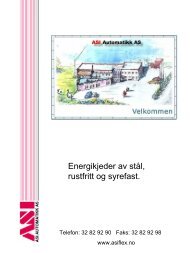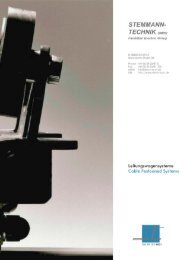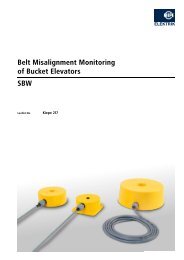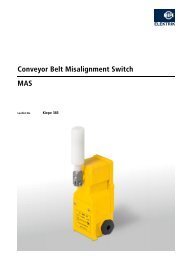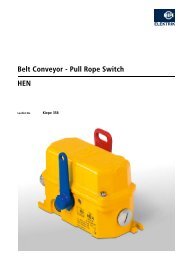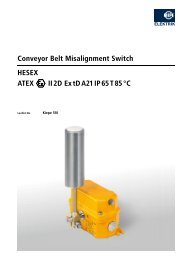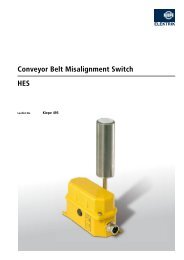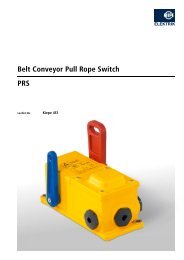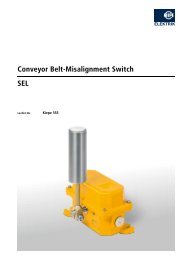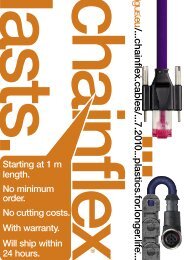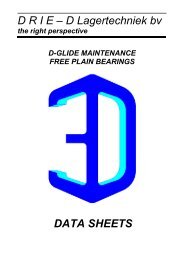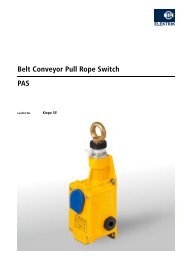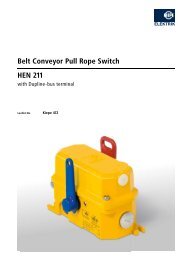DryLin linear guides - ASI Automatikk
DryLin linear guides - ASI Automatikk
DryLin linear guides - ASI Automatikk
Create successful ePaper yourself
Turn your PDF publications into a flip-book with our unique Google optimized e-Paper software.
<strong>DryLin</strong> ® T – Installation Notes and System Design<br />
<strong>DryLin</strong> ® T – Adjusting and Installation<br />
Phone +49- (0) 22 03-96 49-145<br />
<strong>DryLin</strong> ® T<br />
Fax +49- (0) 22 03-96 49-334<br />
igus ® GmbH<br />
51127 Cologne<br />
Internet: www.igus.de<br />
E-mail: info@igus.de<br />
A Lateral Installation with floating bearing in the Z direction<br />
B Horizontal Installation with floating bearing in the Z direction<br />
C Horizontal mounting version with floating bearing in the Y<br />
direction and lateral mounting carriage<br />
1 Rail<br />
2 Sliding elements<br />
3 Carriage<br />
4 Fixed bearing<br />
5 Floating bearing LLZ or LLY<br />
A<br />
B<br />
C<br />
LLZ<br />
LLY<br />
LLZ<br />
Installation notes<br />
Pay close attention that the contact surfaces fixed to the carriage have<br />
a good surface finish (e.g. machined surface), so that the carriage<br />
does not bind. If a carriage is removed from the rail, the end with the<br />
cover which has a part number located at the bottom right, must be<br />
pushed onto the rail first. Rails and plastic carriages are provided with<br />
a mark, ensuring correct orientation of the carriage.<br />
Mounting instructions<br />
When designing systems with 2 parallel rails, one side must be used<br />
with floating bearings. For each mounting version, there is a<br />
recommended fixed floating bearing solution. This installation method<br />
prevents a binding or a locking of the guide when there are parallelism<br />
errors between the rails. The floating bearing is created by the removal<br />
of the static sliding elements. The maximum compensation of parallelism<br />
errors between the mounted rails is 0.5 mm. In the installation, care<br />
must be taken that the floating bearing has equal play in both directions.<br />
You can see our recommended design of the fixed floating bearing<br />
system in the adjacent drawings. The mounting surfaces for the rails<br />
and guide carriages should have a very flat surface (e.g. machined<br />
surface), in order to prevent binding in the system. Variations in the<br />
connection surfaces can also be compensated up to a certain amount<br />
(0.5 mm) by a larger adjusted clearance. The clearance adjustment<br />
is only effective without load. Please contact our technical experts if<br />
you have any questions on the engineering design and/or installation.<br />
Installation of the profile rails<br />
The profile rails will receive all the loads and torques of the <strong>linear</strong> guide<br />
system. The performance of the <strong>linear</strong> guide system is dependent on<br />
the installation method – especially for systems with parallel rails.<br />
Observe the following guidelines during installation.<br />
All surfaces must be clean prior to installation. The profile rails are<br />
mounted along a leading edge or aligned with another reference line;<br />
then the mounting screws are applied by hand.<br />
The screws are tightened in the following steps:<br />
1 All screws first at 30% MA (MA = final torque)<br />
2 Then each second screw at 70% MA<br />
3 The remaining screws at 70% MA<br />
4 Every other screw at 100 % MA<br />
5 The remaining screws at 100 % MA<br />
The following values represent recommended<br />
torque (MA) for the different rail sizes:<br />
TS-01-15: MA = 10 Nm<br />
TS-01-20:<br />
TS-01-25:<br />
TS-01-30:<br />
MA = 14 Nm<br />
MA = 16 Nm<br />
MA = 35 Nm<br />
Use of a straight edge<br />
Place the straight edge between two profile rails, align with a spacer<br />
gauge on the reference rail and affix, then align the profile rail of the<br />
opposing side with the spacer gauge on the straight edge<br />
Adjusting the clearance: <strong>DryLin</strong> ® T<br />
<strong>DryLin</strong> ® T is delivered ready for installation. Clearance of the carriage<br />
is adjusted at the factory. The preadjustment is determined by the<br />
acting forces on each individual system. If you have special<br />
requirements, please indicate in your order whether particularly limited<br />
or extended bearing clearance is required. If necessary, clearance of<br />
the <strong>DryLin</strong> ® T <strong>linear</strong> guide system can be readjusted. This should<br />
always take place when there is no load on the carriage.<br />
1<br />
After removing the protective cover,<br />
loosen the locknuts – Width across flats:<br />
SW 5 for TW-01-15 and for TW-01-20<br />
SW 7 for TW-01-25 and for TW-01-30<br />
Adjust the bearing clearance for the 3 guide<br />
2 points with an Allen key – Allen key size:<br />
1.5 mm for TW-01-15 and for TW-01-20<br />
2.0 mm for TW-01-25 and for TW-01-30<br />
Check the clearance of the carriage after adjusting the 3 levels.<br />
3 If it is sufficient, tighten the locknuts and put on the cover.<br />
There is a danger that excessive reduction of the clearances<br />
4 can seize the gliding elements and that the clearance cannot<br />
be reset simply by loosening the adjustment screws. The<br />
gliding elements are then released by pressing the reset button<br />
on the opposite side. Press hard against the readjusting<br />
spring. You must have already loosened the respective<br />
adjustment screws. Use the correct sizepin for this purpose:<br />
2.5 mm for TW-01-20 and TW-01-15<br />
3.0 mm for TW-01-25<br />
3.0 mm for TW-01-30<br />
Adjusting the clearance: <strong>DryLin</strong> ® T Automatic<br />
The <strong>DryLin</strong> ® T Automatic series offers you an automatic adjustment<br />
of the clearance. A readjustment can take place automatically in steps<br />
of 0.1 mm. Springs tighten the regulating wedge immediately as soon<br />
as the clearance is bigger than 0.1 mm and the system is unloaded.<br />
1<br />
The system will be delivered with 3 spanners which are already<br />
plugged in. They are necessary for mounting the carriage onto<br />
the rail. In case these spanners are removed they need to be<br />
replugged into the openings and turned right by 90°.<br />
When the carriage is on the rail, loosen the spanners by<br />
2 turning them left 90° and remove them. The clearance will be<br />
adjusted automatically.<br />
Check the clearance of the carriage. A fine adjusting can be done<br />
3 at this point.<br />
You can remove the carriage at any time. In order to do so,<br />
4 simply plug the spanners back into the openings (see step 1).<br />
1<br />
2<br />
3<br />
4<br />
1<br />
2<br />
3<br />
4<br />
Lateral guide Vertical guide left Vertical guide right<br />
Phone +49- (0) 22 03-96 49-145<br />
<strong>DryLin</strong> ® T<br />
Fax +49- (0) 22 03-96 49-334<br />
mm<br />
254<br />
Lifetime calculation, CAD files and much more support www.igus.de/en/<strong>DryLin</strong>T Lifetime calculation, CAD files and much more support www.igus.de/en/<strong>DryLin</strong>T<br />
255



